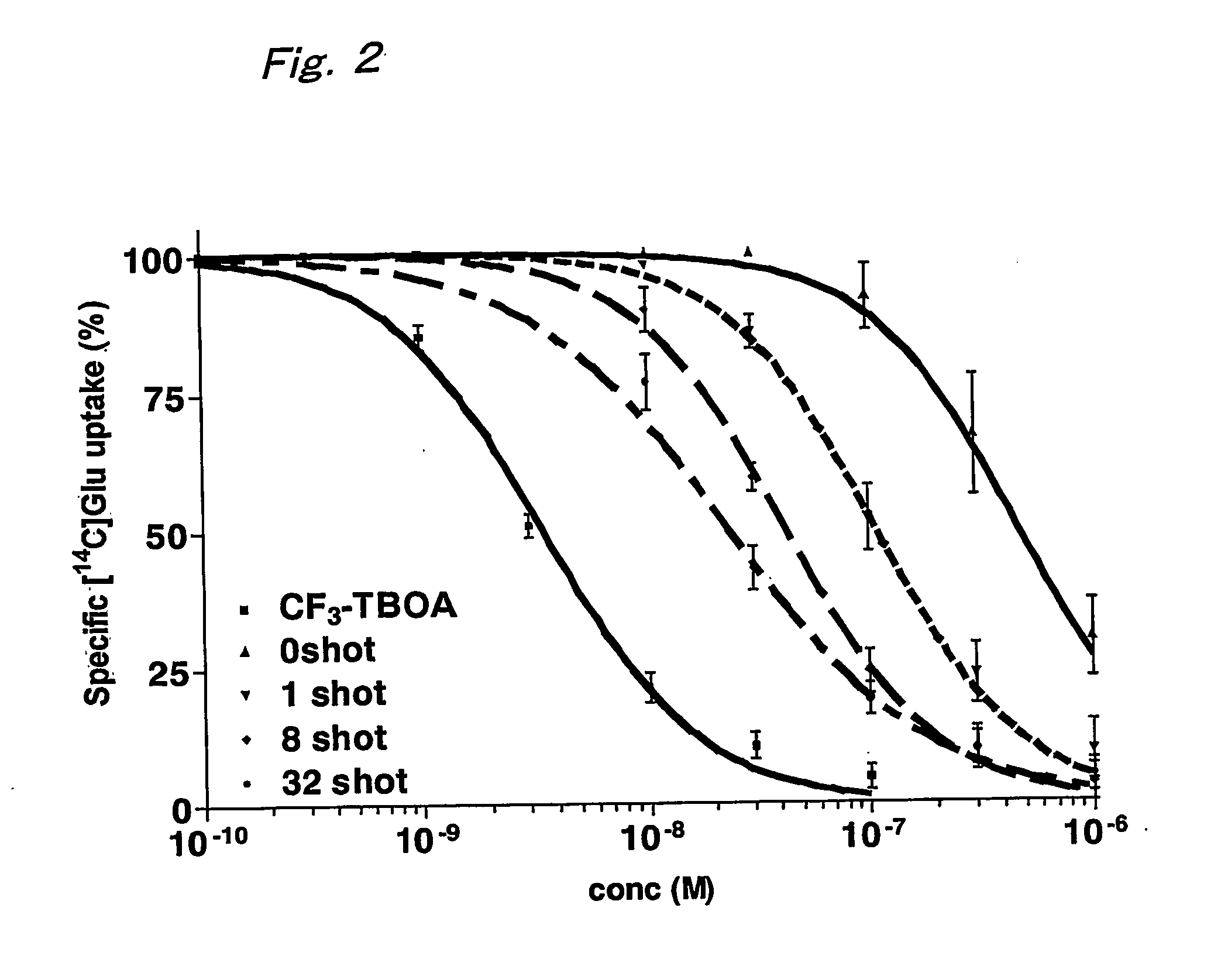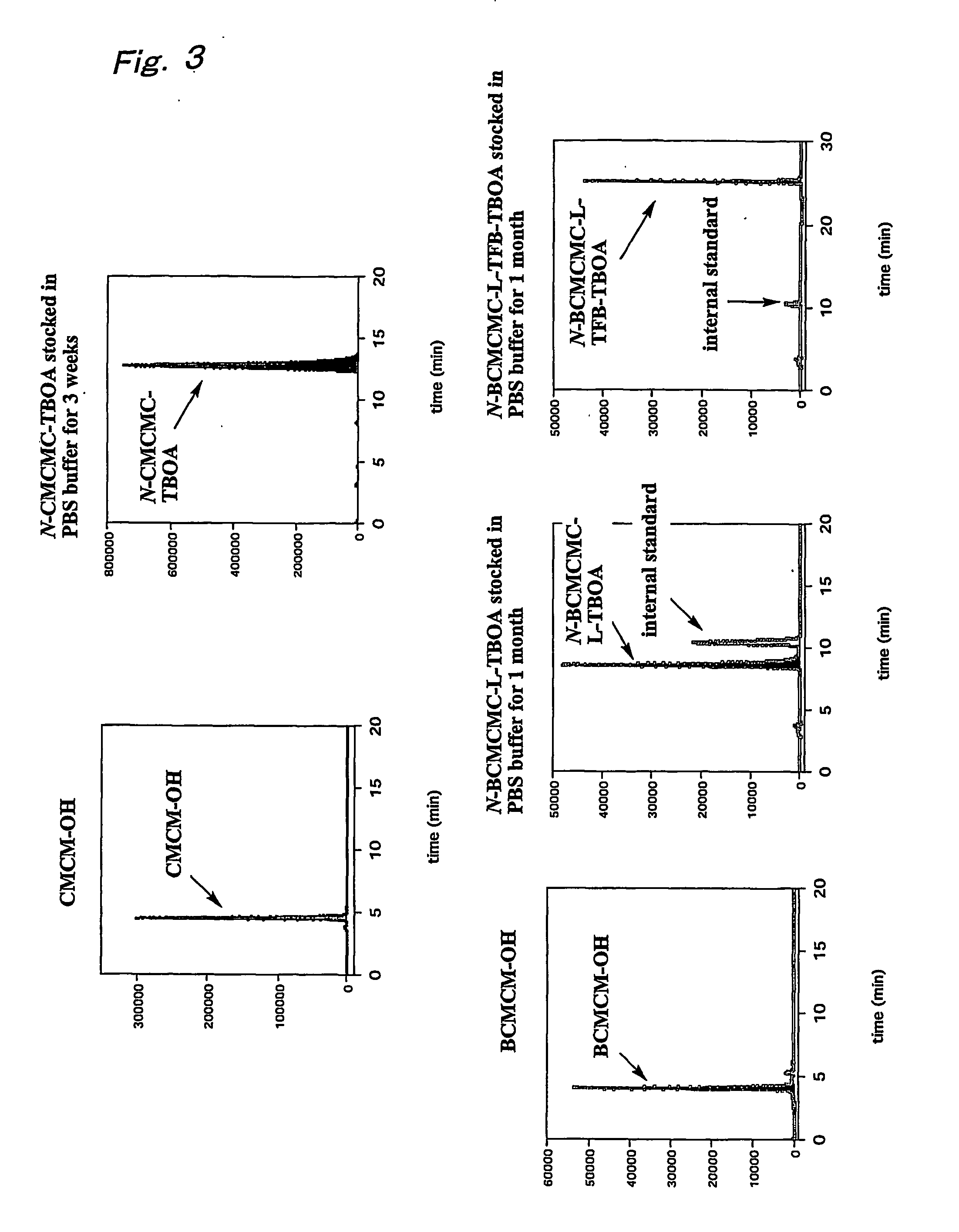B-benzyloxyaspartate derivatives with photosensitive groups
a technology of benzyloxyaspartate and derivatives, which is applied in the direction of biocide, drug composition, peptide/protein ingredients, etc., can solve the problems of difficult control of achieve the effect of controlling conditions, such as cell-specific drug administration or drastic drug concentration increas
- Summary
- Abstract
- Description
- Claims
- Application Information
AI Technical Summary
Benefits of technology
Problems solved by technology
Method used
Image
Examples
example 1
Synthesis of (2S,3S)-3-benzyloxy-N-[7-(carboxymethoxy)coumarin-4-ylmethoxy]carbonylaspartate (N-CMCMC-TBOA: 5a)
[0023] To a solution of compound 1 (149 mg, 0.33 mmol) in CH2Cl2 (2 mL), TFA (1 mL) was added at 0° C. and the mixture was stirred for 1 hour at 0° C. Saturated aqueous bicarbonate solution was added and the mixture was extracted with CHCl3. The extract was purified by silica gel column chromatography to obtain 92 mg of compound 2 (79% yield).
[0024] Next, to a solution of CMCM-OH (3a) (176 mg, 0.7 mmol) in THF (5 mL), trichloromethylchloroformate (0.17 mL, 1.4 mmol) was added prior to reflux for 2 hours, and then the solvent was distilled off. The residue was dissolved in CH2Cl2 (2 mL), and the resulting solution and i-Pr2NEt (0.4 mL, 2.2 mmol) were added to compound 2 (85 mg, 0.24 mmol) in CH2Cl2 (2 mL), after which the mixture was stirred for 10 minutes. The solvent was distilled off and the residue was purified on a silica gel-plate to obtain 84 mg of compound 4 (51% y...
example 2
Synthesis of (2S,3S)-3-benzyloxy-N-[6,7-bis(carboxymethoxy)coumarin-4-ylmethoxy]carbonylaspartate (N-BCMCMC-TBOA: 5b)
[0027] The title compound 5b was obtained by the same procedure as Example 1, from compound 2 obtained in the same manner described above, except for using BCMCM-OH (3b) as the alcohol.
[0028]1H-NMR (DMSO-d6) δ 4.44(d, 1H, J=12.0 Hz), 4.49 (d, 1H, J=3.2 Hz), 4.61 (dd, 1H, J=3.2, 9.6 Hz), 4.75 (d, 1H, J=12.0 Hz), 4.78 (s, 2H) 4.86 (s, 2H), 5.21 (d, 1H, J=16.8 Hz), 5.31 (d, 1H, J=16.8 HZ), 6.41 (s, 1H), 7.00 (s, 1H), 7.10 (s, 1H), 7.28-7.32 (m, 5H) 7.90 (d, 1H, J=9.6 Hz).
[0029] HRMS (FAB) m / z calcd for C26H14NO15(M+H)+ 590.1146, Found 590.1127. [α]25D −9.0° (c 0.32, DMSO).
example 3
Synthesis of (2S,3S)—N-[6,7-bis(carboxymethoxy)coumarin-4-ylmethoxy]carbonyl-3-(4-trifluoromethylbenzoyl)aminobenzyloxyaspartate (N-BCMCMC-TFB-TBOA: 9)
[0030] To a solution of compound 6 (149 mg, 0.23 mmol) in CH2Cl2 (2 mL), TFA (1 mL) was added at 0° C. and the mixture was stirred for 1 hour at 0° C. Saturated aqueous bicarbonate solution was added, and the mixture was extracted with CHCl3. The extract was purified by silica gel column chromatography to obtain 91 mg of compound 7 (74% yield).
[0031] Next, to a solution of BCMCM-OH (3b) (301 mg, 0.69 mmol) in THF (4 mL), trichloromethylchloroformate (0.17 mL, 1.4 mmol) was added prior to reflux for 2 hours, and then the solvent was distilled off. The residue was dissolved in CH2Cl2 (2 mL), and the resulting solution and i-Pr2NEt (0.3 mL, 1.7 mmol) were added to a solution of compound 7 (91 mg, 0.17 mmol) in CH2Cl2 (2 mL), after which the mixture was stirred for 10 minutes. The solvent was distilled off and the residue was purified o...
PUM
| Property | Measurement | Unit |
|---|---|---|
| temperature | aaaaa | aaaaa |
| energy | aaaaa | aaaaa |
| temperature | aaaaa | aaaaa |
Abstract
Description
Claims
Application Information
 Login to View More
Login to View More - R&D
- Intellectual Property
- Life Sciences
- Materials
- Tech Scout
- Unparalleled Data Quality
- Higher Quality Content
- 60% Fewer Hallucinations
Browse by: Latest US Patents, China's latest patents, Technical Efficacy Thesaurus, Application Domain, Technology Topic, Popular Technical Reports.
© 2025 PatSnap. All rights reserved.Legal|Privacy policy|Modern Slavery Act Transparency Statement|Sitemap|About US| Contact US: help@patsnap.com



